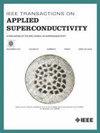Persistent Current Simulation for CCT Testing Magnet Used in EIC
IF 1.7
3区 物理与天体物理
Q3 ENGINEERING, ELECTRICAL & ELECTRONIC
引用次数: 0
Abstract
The Electron-Ion Collider (EIC), a powerful new facility to be built in the United States at the U.S. Department of Energy's Brookhaven National Laboratory in collaboration with Thomas Jefferson National Accelerator Facility, will explore the most fundamental building blocks of nearly all visible matter. There are many different types of superconducting magnets near the interaction region (IR) of EIC. Due to space constraints and special lattice requirements, Tapered CCT (canted-cosine theta) magnets have been used for EIC. At beam injection, the magnetic field is only ∼5.5% of the maximum operating field. Considerable field errors will be generated from persistent current in superconducting strands even using very fine filament for those superconductors.A tapered CCT demonstrator magnet has been built and tested successfully at BNL since July 2020 to evaluate the key technologies for future tapered CCT magnets. In October 2023, BNL team also measured the persistent current in this demonstrator magnet. To validate the persistent current simulation methods for CCT magnets in EIC, this paper used a full 3D Opera Model and measured magnetization data from superconducting strand for the simulation. Simulation results showed reasonable agreement with recent measurement results.求助全文
约1分钟内获得全文
求助全文
来源期刊

IEEE Transactions on Applied Superconductivity
工程技术-工程:电子与电气
CiteScore
3.50
自引率
33.30%
发文量
650
审稿时长
2.3 months
期刊介绍:
IEEE Transactions on Applied Superconductivity (TAS) contains articles on the applications of superconductivity and other relevant technology. Electronic applications include analog and digital circuits employing thin films and active devices such as Josephson junctions. Large scale applications include magnets for power applications such as motors and generators, for magnetic resonance, for accelerators, and cable applications such as power transmission.
 求助内容:
求助内容: 应助结果提醒方式:
应助结果提醒方式:


